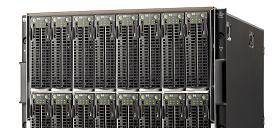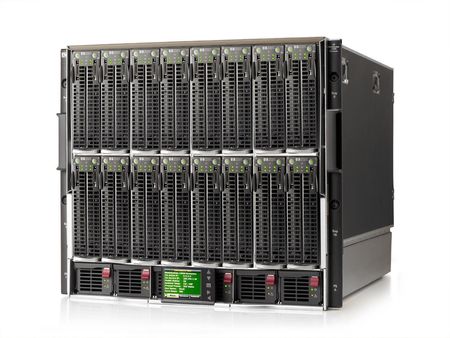HP Puts 1000 Cores in a Single Rack

Want to get the most processing power possible in your data center to run cloud computing and Web 2.0 apps? HP is introducing the ProLiant BL2x220c G5 server blade today, which doubles the processing density by putting two servers into each half-height blade. Using Intel Xeon 5400 quad-core processors, you can put up to 1024 cores and 2 terabytes of RAM in 128 servers in a 42U c-Class rack – that’s 12.3 teraflops in eight square feet.
Fitting two servers into a single blade means leaving some things out, Iain Stephen, HP’s vice president for industry standard servers, said.
“The memory, the drives, the processors and the heatsinks are the things that take up the space in a server,” Stephen said. “We stripped off the things customers tell us they don’t value: we stripped off the hot pluggable storage; we stripped off the storage redundancy; we reduced the memory footprint and we have a smaller number of DIMM sockets. When a customer looks at the 220c, they may think it’s underspecified. But on the connectivity side we’ve enhanced things; we can add InfiniBand or high-speed Ethernet. It’s a balance. If I already boot from network-attached storage, if I’m running an app where four DIMMs are sufficient, if I can compromise on local storage and the memory footprint – then I get the processor density."
HP expects customers to use the dual gigabit Ethernet network interface card and optional x8 PCI-Express mezzanine socket allowing 4x double data rate InfiniBand to connect to storage arrays like HP’s petabyte-scale ExDS9100 instead of using storage inside the rack. Making room for more processors creates a much more efficient system, Stephen said. “You have to balance the amount of processing per square foot and the power requirements. You can either drive towards ultimate density or the ultimate in efficiency, but with the 220c you get three times the density of a 1U rack,” Stephen said. “We use the same power supplies, the same fans and the same chassis, but we double up the density and hopefully get 60% better performance per watt.”
Specifically, HP claims a 60% performance-per-watt advantage over a cluster of Dell PowerEdge 1955 servers. In HP’s own tests using the SPECjbb2005 benchmark to measure business operations per second, the BL2x220c delivers 1,582.73 bops/watt compared to 958.86 bops/watt with PowerEdge.
The approach does share similarities with IBM’s iDataPlex system for Web 2.0 computing, Stephen said. “There are only so many things you can flex in the x86 architecture,” Stephen said. “You can flex the I/O, the processing, the number of sockets and cores, the memory – these are the core technologies. We’re flexing the same number of things but the way we deliver the balance is slightly different to the way IBM delivers iDataPlex.”
HP isn’t adding water cooling or other extreme measures to the new blades. Instead, it relies on the c-Class chassis’ features, such as the ability to turn off four or five of its six power supplies to deliver power at 90% efficiency. The c-Class chassis also uses 10 Active Cool Fans, based on the design of jet engines for radio-controlled model aircraft. The fans run at up to 166 miles per hour and are more efficient than the fans in each server.Initially, HP is offering only Intel Xeon 5400 quad-core or Xeon 5200 dual-core processors. HP will have AMD’s quad-core Barcelona processors in other ProLiant servers while Stephen said there could be a dual-server Barcelona blade if there’s demand. “Intel has had a performance advantage since May last year so the majority demand is for Intel processors,” Stephen said. “If Barcelona delivers - and I think it probably will - I expect customer demand to split between the two again.”
Get Tom's Hardware's best news and in-depth reviews, straight to your inbox.
Although most customers for the BL2x220c blades will be businesses running cloud computing and Web 2.0 applications or high-performance computing systems where fitting in thousands of servers at a time is critical, with prices starting at $6,349 Stephen predicted the blades will appeal to some smaller companies. “There will be small business customers who look at this and say ‘we’re already using a small storage network, and these are ideal to use as file and print servers, Web servers and application servers,’” Stephen said. But one of the first systems will go to special effects company WETA Digital for use on films like James Cameron’s “Avatar,” “Neon Genesis Evangelion” and the “Halo” adaptation.

Two servers in each blade, four cores in each server: the HP ProLiant BL2x220c G5 fits in twice as much processing for Web 2.0.
-
"Specifically, HP claims a 60% performance-per-watt advantage over a cluster of Dell PowerEdge 1955 servers"Reply
Right, compare a blade to a classical 1u or 2u server. Don't compare it to Dell's blade servers because it'll smoke the HPs 8 ways to sunday. -
Due to the efficiency of the power supplies and the solid-state disk drives, I would still think it would beat the Dell blade offerings in terms of performance per watt. But this is really a density play, not necessarily an efficiency play though it does beat just about any rack mount in that too. With Dell's engineering not pushing the envelope in blade hardware, it may be awhile before they can answer this. Just $6400 for two quad-core Xeon servers? That is also a price point other vendors (IBM, Sun) are going to be loathe to compete with. If I was Google or Yahoo, I'd by rooms full of these and retire all of that desktop hardware they are using for servers.Reply
-
koreberg @ThranxReply
The 1955 is not a rack mount server, that would be a 1950. 10 1955s fit in a 7u chassis, it is not their latest product, but it is in fact a blade.
It would be a more equal comparison if they had chosen the dell m600 or m605, which is the new blade system. However there are numerous other reasons to go with HP. -
recones90 Specifically, HP claims a 60% performance-per-watt advantage over a cluster of Dell PowerEdge 1955 servers"Reply
Yeah, compare it against DELL's previous generation of blades to get big numbers. I bet you that HP doesn't do so well against DELL's current generation of Blades (M600). -
aznguy0028 why does every technology page/thread always have a Crysis joke in it? said and repeated so many times to the point of annoyance.Reply -
markhahn why do vendors get off on this kind of engineering masturbation? people who are in the market for significant compute farms are simply not interested in paying more for this kind of absurd density. density, after all, does not improve price/performance, or power efficiency, or managability, or peak performance. it's just a number to brag about, and it's not all that impressive anyway (commodity parts can easily put 4 sockets in 1U, and thus 672/rack. such systems are cheap, commoditized without vendor lock-in, and yes, have more dimms/socket and 90% PSU's.)Reply
when I see actual blade installs, I always have to laugh, because they're usually some easily impressed PHB buying a penis substitute, which winds up with one chassis alone in a rack because the machineroom can't handle the power density.
blades: just say no to boutique packaging of commodity parts.